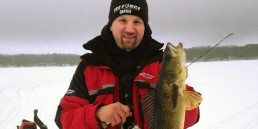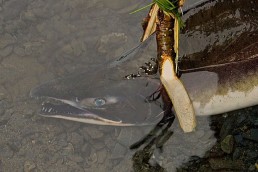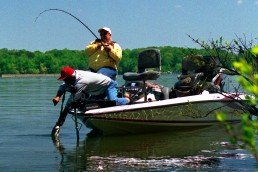Go UV or Glow When It’s Go-time
SHARE THIS POST
In clear-water lakes, the major bite window for walleyes is usually pretty tight, and close to sundown. During this time, the lake does go pretty dark rather quickly. Anything that you can do to increase your odds of a fish finding your lure is key. And in stained water, the bite typically will be an extended special window.
Fisheries biologists have said that predatory fish can see reflected UV light. UV-reflective patterns on the skin of fish can help them in their identification of different species in the water. In other words, it can help them determine if a nearby fish is an enemy, prey or even a mate. On a smaller scale, microscopic food such as zooplankton can be seen a little easier if they reflect UV light.
Humans cannot see ultra-violet light, so that always makes some skeptical. But if it gives you just a few more bites, well that’s a few more bites. I do know that if a fish never sees the presentation then there is a 100 percent chance you won’t catch it.
Ultra-violet coatings seem to be the trend in many lures, as it’s supposed to make the bait stand out a little more. During low-light transition times, it makes sense to try to be seen. Anything you can do to make it easier for the fish to see the lure when they are hungry is a good thing, within reason.
Up in the Ice Belt, we also have added “layers” that reduce light penetration—called ice and snow. So on overcast days with the ice and snow, the light levels are going to be a little less ideal than on a calm, full sunny summer day. At high noon on a midsummer day, a UV-coated lure may not be necessary at all. In fact, it may be too much unless you are fishing in mud. But through the ice and snow, it may always be a viable option.
Are you enjoying this post?
You can be among the first to get the latest info on where to go, what to use and how to use it!
The science of it is that water absorbs normal light and will also absorb UV light. How far the UV light will actually travel into the depths will obviously vary depending on the snow, ice and water clarity. So, the shallower you are fishing, the better the chances are of it making a big difference.
Glow paint has been around for quite some time now, and many anglers have reaped the rewards of this novel idea. Simply zap the lure with a bright light for a bit and then drop the presentation down into the depths. This lure will then glow at whatever depth you are fishing for a given duration. So, at primetime when the sun is sinking into the horizon, you have another option to use to be more visible to the fish below.
After dark, these patterns and colors can be a no-brainer for fishing crappies and walleyes, as they will literally stand out as if a magical spotlight is shining upon them.
Northland Fishing Tackle offers both the UV paint options as well as their Glow colors for many of their ice fishing offerings. Most other companies, such as VMC, offer many different glow-color options to give you an advantage while on the ice.
Take advantage of the technology and options and make sure you are equipped with the best tools possible. Of course, you still need to be in a good spot so be sure to get out there and do your homework. Next time you are looking for a little edge over your fishing buddies, tie on a UV-coated lure or a glow lure before primetime and see what happens. Maybe you will all of sudden be the one with all the luck.
MWO
SHARE THIS POST
Did you enjoy this post?
You can be among the first to get the latest info on where to go, what to use and how to use it!
Steve Mattson
Steve Mattson has been writing articles for MidWest Outdoors since 2001. He is a driven angler, guide and sponsored tournament pro who has won both bass and panfish tournaments, and has placed in walleye and pike events. He resides in northern Minnesota and enjoys helping others catch more fish. For more info: mattsonangling.com and @mattsonangling.



